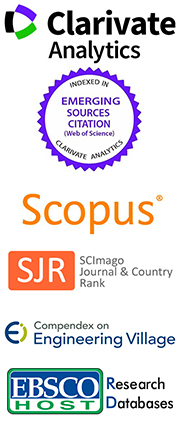Floating PV Systems with Single-Axis Solar Tracking
Abstract
Keywords
Full Text:
PDFReferences
Prasartkaew B. and A. Ngernplabpla. 2014. Investigation on the performance of a paraboloids heliostat for concentrated central receiver solar collector. In Proc. 6th Int. Conf. on Science, Technology and Innovation for Sustainable Well-Being (STISWB VI): Siem Reap, Cambodia.
Prasartkaew B. and S. Sukpancharoen. 2021. An experimental investigation on a novel direct-fired porous boiler for low-pressure steam applications. Case Studies in Thermal Engineering 26: 101-169.
International Energy Agency, 2021. World Energy Outlook 2021, Paris: IEA Publications.
Prasartkaew B. and S. Kumar. 2014. Design of a renewable energy based air-conditioning system. Energy and Building 68: 156–164.
Prasartkaew B., 2018. Efficiency improvement of a concentrated solar receiver for water heating system using porous medium. IOP Conference Series: Materials Science and Engineering 297: 012-059.
United Nations Environment Programme, 2020. Emissions Gap Report 2020, UNEP Publications.
Lewis N.S. and D.G. Nocera. 2006. Powering the planet: Chemical challenges in solar energy utilization. Proceedings of the National Academy of Sciences USA 103(43): 15729–15735.
Fthenakis V.M., 2009. Sustainability of photovoltaics: The case for thin-film solar cells. Renewable and Sustainable Energy Reviews 13(9): 2746–2750.
Fraunhofer Institute for Solar Energy Systems, 2020. Photovoltaics Report: [Online] Available: https://www.ise.fraunhofer.de
Intergovernmental Panel on Climate Change, 2018. Global Warming of 1.5°C: IPCC.
Choi Y., Lee K., and Kim H., 2014. A study on power generation analysis of floating PV system considering environmental impact. Environmental Science and Technology 48(22): 13125–13132.
Liu H., Wang Z., and He W., 2017. Evaluation of floating photovoltaic systems’ cooling effect on photovoltaic panels. Journal of Renewable Energy 21(3): 319–328.
Chatterjee S. and A. Chatterjee. 2019. Types and benefits of solar tracking systems in photovoltaic applications. Renewable Energy Reports 24(2): 45–54.
Kacira M., 2016. Analysis of single-axis and dual-axis tracking PV systems: Efficiency and cost implications. Solar Energy 134: 14–23.
Sanchez J. and F.J. Batlles. 2019. Performance analysis of single-axis tracking PV systems: A case study. Energy Conversion and Management 182: 46–58.
Mizuno T., 2017. Performance improvements in floating solar plants with tracking mechanisms. International Journal of Photovoltaic Systems 6(4): 110–115.
Choi J., Lee K., and Kim H., 2014. A study on power generation analysis of floating PV system considering environmental impact. Environmental Science and Technology 48(2): 13125–13132.
Liu H., Wang Z., and He W., 2017. Evaluation of floating photovoltaic systems’ cooling effect on photovoltaic panels. Journal of Renewable Energy 21(3): 319–328.
Liu H.Z., Li C.T., and Zhang J.W., 2020. Environmental benefits of floating PV on artificial water bodies. Energy Reports 6: 1216–1222.
Smith R. and L. Jones. 2019. Global adoption trends in floating photovoltaic systems. International Journal of Renewable Energy 23(1): 1–9.
Mizuno T., 2017. Performance improvements in floating solar plants with tracking mechanisms. International Journal of Photovoltaic Systems 6(4): 110–115.
Wang L., Zhao Q., and Zhou X., 2020. Challenges and advancements in tracking mechanisms for FPV systems. IEEE Transactions in Sustainable Energy 11(2): 486–493.
Patel N. and P. Kumar. 2021. Comparative analysis of land-based and floating PV systems under varying environmental conditions. Renewable Energy 29(2): 204–210.
Erbs D.G., Klein S.A., and Duffie J.A., 1982. An equivalent mean day calculation to predict monthly average daily utilizability for flat plate collectors. Solar Energy 28(6): 413–417.
Prasartkaew B. and S. Kumar. 2013. Experimental study on the performance of a solar-biomass hybrid air-conditioning system. Renewable Energy 57: 86–93.
Prasartkaew B. and S. Kumar. 2010. A low carbon cooling system using renewable energy resources and technologies. Energy and Buildings 42(9): 1453–1462.
Duffie J.A., Beckman W.A., and Blair N., 2020. Solar Engineering of Thermal Processes, Photovoltaics and Wind: Wiley.
Prasartkaew B., 2013. Mathematical modeling of an absorption chiller system energized by a hybrid thermal system: Model validation. Energy Procedia 34: 159–172.
DOI: https://doi.org/10.64289/iej.25.0309.2892571


